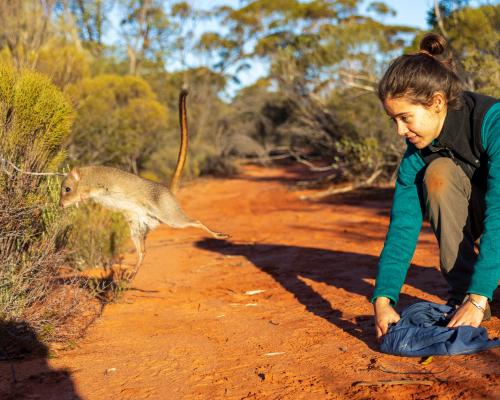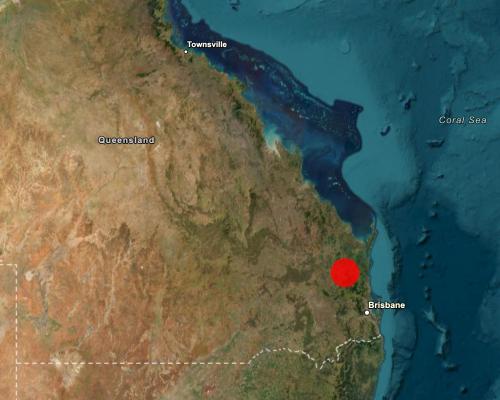
Like a ball of fur mounted on a spring, they leapt into the crisp night air and on to a landscape of acacia scrub where they hadn’t roamed free for maybe a 100 years or more.
The Australian Wildlife Conservancy (AWC) last month released 147 of the brush-tailed bettongs on to its sanctuary at Mount Gibson, about a four-hour drive northeast of Perth on the edge of the wheat belt.
“When we open the bag, their first thought is just ‘we’re outa here’,” says Dr Bryony Palmer, a wildlife ecologist at the conservancy.
Sign up: AU Breaking News email
“While they’re in the air they figure out where they are and then off they go.”
The bettongs had been taken from inside an 8,000-hectare fenced “safe haven” within the sanctuary – away from the teeth of feral cats and foxes – where 162 of them released there in 2015 have now grown to about 1,000.
With cats and fox numbers being managed by the conservancy outside the fence, the hope is the bettongs, also known as woylies, will survive and thrive as they once did before Europeans introduced cats and foxes that are prodigious native wildlife killers.
From bilbies and numbats to quolls and phascogales, eight threatened native mammal species – all once locally extinct – have successfully been reintroduced over the past decade since the conservancy bought the 130,000 hectare former sheep property in 2000.
‘5% of Australia’
This week, AWC will reveal an ambitious strategy to expand this kind of project well beyond its already sizeable footprint across the Australian continent.
If you add the 6.8m hectares of land AWC owns or partners on purely for conservation to the 6.1m hectares where it works mostly with pastoral companies to improve conservation, “then that’s significant, globally – it’s about 1.7% of Australia” the chief executive of AWC, Tim Allard, says.
By 2035, the organisation hopes to expand the area where they are carrying out conservation work – either on their own properties or on land being used for other things, such as cattle grazing – to about 5% of Australia’s land mass.
“This is about where we want to be. But it’s what we think is necessary to secure Australia’s natural heritage,” says Allard.
Australia’s unenviable record on mammal extinctions – the worst in the world – is well known. The federal government has promised no new extinctions and pledged to have 30% of land protected by 2030 – part of a global “30×30” conservation goal.
“On 30 by 30, we have been at pains to say that if that land is not being effectively conserved, then it’s all for naught,” says Allard.
“30 by 30 is about protecting areas but increasingly we have to think beyond that. About 54% of Australia is managed for pastoralism. We have to find a way to have sheep and cattle and conservation working together.”
The 30x 30 target for Australia includes everything listed on a national reserve system and currently 24% of the land is protected in areas like reserves and parks managed by local and state governments, the commonwealth and not-for-profit conservation groups like AWC.
To reach its lofty goals, Allard says the organisation wants to grow from its current $40m a year revenue that comes mostly from philanthropy, to a $100m-a-year organisation.
The conservancy hopes the new high-profile appointment to its board of former NSW Liberal treasurer Matt Kean, the current chair of the federal government’s Climate Change Authority, will help increase its reach and raise more funds.
“We’re drawing a line in the sand. This plan is the boldest private response to the extinction crisis in our nation’s history,” says Allard.
“We have a major challenge in this country with the decline in biodiversity, but we also have a massive opportunity.
“We want to give people some hope. The goal is to grow that philanthropy. Only about 2% of charitable giving in Australia goes to the environment.
“Most of the world’s biodiversity is in the southern hemisphere, but most of the money is in the northern hemisphere. We have to find ways to sell Australia internationally.”
Ecosystem engineering
Back at Mount Gibson, the bettongs released last month are being tracked every two days with the help of radio collars on 20 of them.
Palmer is getting ready for the arrival of a team of botanists to survey the sanctuary to see if the re-introduction of the small mammals has started to help more native plants grow.
A lot of Australia’s smaller mammals are “ecosystem engineers” that help spread seeds and improve soils with their digging.
“When you walk through the fenced area, there are these little dig holes everywhere with little seedlings growing in them.”
Those benefits might be spilling out of the fenced area.
“We’ve started to get records of the bettongs outside the fence,” says Palmer. “It’s six foot high, but they’re good climbers.”





